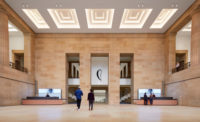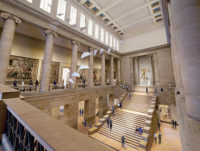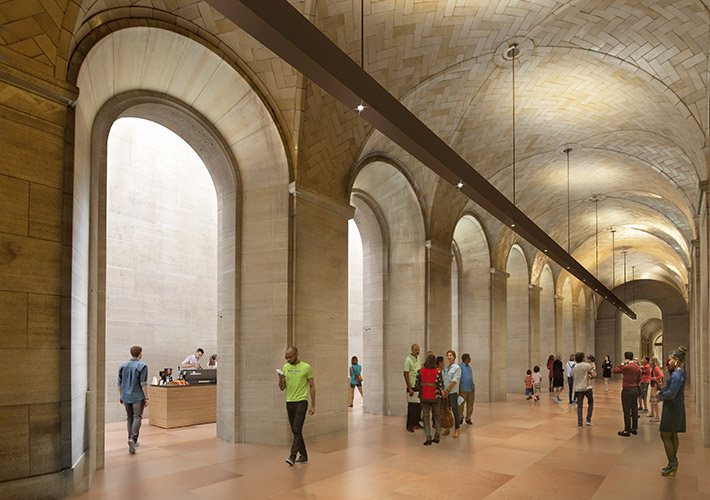Philadelphia Museum of Art Reopens Long-Forgotten Spaces as Part of its Frank Gehry-Designed Renovation

The reopened north entrance, used as a loading dock for decades, includes 24-foot-tall ceilings.
Photo by Tim Tiebout, courtesy Philadelphia Museum of Art, 2019

One half of a dramatic north-south axis has been reopened, its Guastavino vaults meticulously restored.
Photo by Joseph Hu, courtesy Philadelphia Museum of Art, 2019

Next fall, the full 640-foot length of the vaulted walkway will be accessible to the public.
Rendering by Gehry Partners and KX-L, courtesy Philadelphia Museum of Art, 2019

A former lightwell has been covered with a skylight whose structure mimics that of the vaults over the adjacent walkway.
Photo by Tim Tiebout, courtesy Philadelphia Museum of Art, 2019

A multilevel circulation hub, dubbed the forum, will open next year.
Rendering by Gehry Partners and KX-L, courtesy Philadelphia Museum of Art, 2019





Architects & Firms
Frank Gehry talks about the porticoed and pedimented structure that houses the Philadelphia Museum of Art as though it were a living being, referring to its “good bones” and its “heart.” The Pritzker Prize–winning architect has been involved in renovating the 1928 Beaux Arts building at the head of Philadelphia’s Benjamin Franklin Parkway since 2006, when his Los Angeles-based firm was hired to develop the museum’s master plan. The long-range set of projects aims to replace antiquated building systems, create new galleries, and improve wayfinding and circulation, which Gehry says had become confusing and “muddled” after earlier modifications. The museum had “clogged up arteries,” he explains.
Full completion of all the construction outlined by the master plan is many years away, but visitors now have a sense of Gehry’s approach to remedying this situation. Earlier this week, on September 18, an historic entrance on the museum’s north side reopened, as did about half of a striking vaulted walkway, running from one side of the museum to the other. Though conceived as public spaces by Horace Trumbauer and Julian Abele, the museum’s original architects, both the entrance and the passage had been long off-limits to museumgoers, having been used as a loading dock and for storage since at least the mid 1970s.
Gehry is of course best known for his expressively sculptural buildings. But here his hand is barely discernable: sleek bronze fixtures suspended from the vaults illuminate the meticulously cleaned Guastavino tiles; a lightwell formerly exposed to the elements has been captured as skylit indoor space and is now home to an espresso bar; and new floors, from the same quarry in Minnesota that supplied the limestone used in the original construction, conceal extensive infrastructure for heating, cooling, telecommunications, and electrical systems. Gehry describes his role akin to that of an archaeologist. He says he is “excavating” Trumbauer and Abele, and that he is quite satisfied doing so. “My other work offers plenty of opportunity for self-expression.”
The just-opened half of the walkway and entrance are only two pieces of the current phase of construction known as the core project, for which demolition began in 2017. By next fall, when this stage of the master plan is scheduled to be complete, more than 90,000 square feet of renovated space—including 23,000 square feet of new galleries and the full, 640-foot length of the vaulted walkway—will be open to visitors. Also slated to be done next year as part of this $220 million phase, is what has been dubbed the forum—a new, double-story circulation hub and gathering space that connects the walkway to the rest of the museum. It was made possible by demolition of an auditorium built in 1959 and required structural gymnastics, such as underpinning its foundations.
Future phases of Gehry’s master plan, which are not yet scheduled, will move forward as resources permit, say museum officials. They include a new auditorium as well as more galleries. These exhibition spaces are to be dug underneath the east terrace and its monumental steps (the steps familiar to anyone who has seen the 1976 movie Rocky). The design also calls for a portal-like window that will slice through the stairs and offer views out over the parkway and of the Philadelphia skyline. Gehry insists that even this “window to the city” was part of Trumbauer’s vision. “We didn’t create a new master plan,” he says. “We’ve recreated an existing one.”









